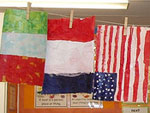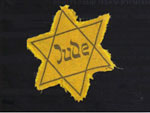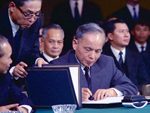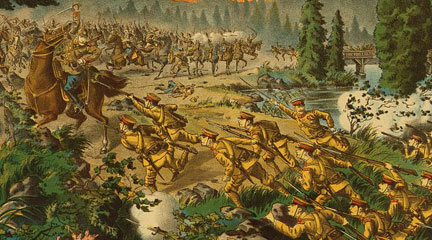The source is a diary that was kept by a Foreign Service officer named Robert Ode. Mr. Ode was a combat veteran of World War II, and after the war joined the Foreign Service as a clerk. He worked his way up through the ranks to become a Foreign Service Officer. He was forced to retire by a mandatory retirement law at age 60 in 1975. Thereafter, he took occasional work as a contractor for the U.S. government. He happened to take a job for the State Department that involved traveling to the embassy in Tehran, supposed to be for only 45 days. He arrived in the fall of 1979. In a perfect case of being in the wrong place at the wrong time, he was in the embassy in Tehran when it was overrun by the student militants on November 4th. Thus his 45-day assignment became a prolonged assignment because he remained in captivity—as the other 51 hostages did—for 444 days until they were released on January 20, 1981.
During his captivity he eventually got permission to begin recording his thoughts. He didn’t start writing immediately, he was eventually given permission, and he retrospectively wrote back to the onset of the hostage crisis on November 4, 1979. Then he wrote on an occasional basis, not quite a daily basis, for the duration of his captivity. The final product is a diary of 115 pages, it's available at the Jimmy Carter Library in Atlanta, GA, and a substantial excerpt of it is posted on the website of the Carter Library; so it’s readily accessible by electronic means in any classroom in the country.
115 pages is perhaps a daunting length for a primary source for high school instruction, but I think that teachers can effectively and rather easily find the “meaty excerpts” to which they can guide their students for a greater understanding of what the document reveals.
What I like about this document is it’s a first-person narrative by a participant who was involved in one of the most sensational events in U.S. diplomatic history. It’s not a study of the making of official American foreign policy by the Oval Office or by the subfloor of the State Department, by the Secretary of State; but rather it’s a record of the day to day experiences—of the real life impact of an international event on an individual Foreign Service Officer who experienced that event in a very personal, first hand, and day in and day out way.
What I like about the document is that it reveals the human side of international relations. It does not reveal why policy was made or how policy was made, but it shows how policy was experienced by a key official who was caught in the wrong place at the wrong time. Nothing much will be learned from this diary about the origins of the hostage crisis, about why it erupted, about how it was settled, about what kind of negotiations ensued between Carter and Khomeini. But what is learned is how the hostage ordeal affected the 52 individual American government employees who experienced it on a day-to-day basis.
In that sense, it’s kind of like studying the New Deal not by looking at the policy made by Franklin Roosevelt, but rather by reading the account of the Okies. Or it's about learning about World War II not by studying the decisions of the generals, but by looking at the lived experiences of the soldiers who swarmed up onto the beaches in the face of enemy gunfire. So it does have to be supplemented with studies or explanations of what’s happening at the top level, what’s happening between the Carter government and the Khomeini government, but this document does bring to life the actual, real experience of what took place in the lives of the Iran Embassy employees.
1979 had been a very tumultuous year. The Khomeini regime had taken over in the early months of 1979 and the U.S. embassy had remained in business throughout the duration of the year. Although—because of historic tensions between the Iranian people and the U.S. government—there were frequently demonstrations in the neighborhood, in the street in front of the embassy, with mobs of students and others walking by and chanting nasty slogans about the U.S. By the end of 1979 the embassy staff had almost gotten accustomed to it, it was like the background noise. Of course they were concerned about it, but they had sort of settled into a relatively comfortable routine.
The events of November 4th, when they first started, there was initially an assumption that just business as usual in a heightened state of tensions. But then obviously as these dramatic events unfolded the officials realized that, no, this is actually something new and different.
The first excerpt that is worth seeing is right on page 1 and page 2 and that is Mr. Ode’s firsthand testimonial about being taken captive. He reports that he was engaged in routine business at the embassy in what seemed like a routine day. On this day in particular, though, suddenly the embassy was aglow with activity. There were some indicators that some students had breached behind the security wall and were causing some worry and consternation. A Marine Corps guard came in and advised that he and his colleagues move from one part of the embassy to another. Still nothing apparent that a major ordeal was about to ensue. Mr. Ode was asked to escort an elderly gentleman from the chancery building, so he walked outside with this elderly man, who got in a car and drove away. Then he and some of his colleagues decided that maybe what was happening in the embassy was unsettling enough that they should walk up the street to another U.S. government facility. They begin to walk away and are quickly surrounded by a group of students who were armed, who demanded that they go back to the embassy. They tried to protest that as diplomats they had immunity and should be free to go. Someone fired a shot over their heads which got their attention, [so] back to the embassy they went. And before long they were bound and blindfolded with the other hostages, paraded before the cameras, and maltreated as many realized was the case.
It’s interesting how Mr. Ode records in his diary an explanation or a narration of what’s happening to him and his colleagues around him. He does so in a very professional and detached way, he’s not panicking. Now some of that might be because he was recording these events some time after they happened, some of it might be that as a career Foreign Service Officer he had been trained and professionalized to remain professional and rational and not emotional even in times of great duress. The man was a combat veteran of World War II, he had been involved in a couple of amphibious assaults on Pacific islands with enemy soldiers firing at him, so he’d been through difficult places before in life. He probably also anticipated that the trouble was not going to last for long—maybe a day or two, or a week at the most—and then the government at home, the U.S. government, would do something to liberate or rescue him; or the Iranian government would intervene and force the captors to relinquish their prey and so forth. So he probably figured it was a temporary inconvenience and that he would be going home right on schedule at the end of his 45 days.
No one knew at the time—in fact, from what we can tell even from Iranian records, not even the Iranians realized at this point in time that the Hostage Crisis was going to last so long. Those who took the Americans captive figured it would be a couple of days or a week at the longest, some of them thought that the Iranian government would intervene within hours to relinquish the captives. To their surprise Ayatollah Khomeini gave his blessing to the deed. That actually then created a political “perfect storm” in which the Hostage Crisis endured simply because of the political context in Tehran and no one forcing it to end and the U.S. government’s hands seemingly tied by the difficult circumstances against it.
So the bottom line is that Ode might not have realized at the time it was going to become a major sort of life-changing and very demoralizing ordeal, as it eventually became. Some of the other striking features of diary include the way that Ode interpreted events that we knew at that time and we certainly know in retrospect were happening on the international stage, but were unknown to him—at least unknown to him in great detail. Two examples. There was an attempt by the Carter administration to rescue the hostages by military means in late April 1980. It’s a famous and very tragic story in American history, in which the Defense Department sent a fleet of soldiers on helicopters into Iran with the mission of flying into Tehran under the cover of darkness, landing at the grounds where the hostages were being held captive, chasing away or killing the captors, liberating the hostages, loading them onto helicopters, and flying them to freedom.
Unfortunately the operation experienced technical difficulties at the outset, some of the helicopters were disabled by a sand storm; a decision was made early in the procedure to abort the operation. Then in the haste to abort, a couple of aircraft collided and there was an explosion and several U.S. GIs were killed. At that point in time the Iranians did not yet know there were American rescuers on their soil, en route to Tehran to liberate. They would only learn of the operation after it had failed and after the hasty departure of the American forces.
We can see the impact of that event in Ode’s diary, even though he is not cognizant of the details of the operation. He does not understand that there was a rescue operation; but if you cross check the dates you can discern the impact of the failed rescue mission on the status of the hostages, even though the hostages themselves had no idea what had happened. They wouldn’t learn for a couple of months that a rescue had been attempted.
The diary that reveals the impact of the failed rescue mission appears on page 23, and it’s the entry for April 25, 1980. Mr. Ode writes:
“Big demonstration outside the Embassy again today with much shouting of slogans, everything amplified to the highest degree as usual, also much horn tooting… About 4:45pm we were told to pack everything up as we were being moved to a ‘much, much better room’ and that we should be ready in 10 minutes. Bruce and I got our things together, which meant gathering up the accumulation of the past two months that I have been in this particular room and we then proceeded to wait.
“No one came for us in 10 minutes and after a couple of hours Hamid came in and told us to take only one blanket and just the essentials for the night—also to take just two books and that everything else would be brought to us within a day or two. This meant going through everything again as we had taken all the loose items such as toothbrush, razor, shaving cream, our letters, photographs, etc. as well as our clothing.
"Hamid told us to leave most of our clothing behind that it too would be brought to us later. However, since I don’t trust anything he told me I packed it anyway and also the electronic mosquito destroyer and other miscellaneous items as, of course, we were not give any idea where we were going except that it was to be a ‘much, much better room’ and from the activity going on in our building we felt that it would definitely be off the compound although at first we were under the impression we were just moving upstairs. Then our supper was brought in and we still weren’t being moved.
"Finally, seven hours later approximately 1:00am,”—this would be April 26—“I was told that I was to sleep in our room and that only Bruce was to be moved. I was so angry I told everyone off and was reminded that ‘I was not polite!’—also that ‘older men should be more polite!’ So it appears that I will again be punished for ‘being impolite!’"
This passage reveals a feeling of energy and a feeling of panic among the Iranian captors; it also shows the confusion that followed the discovery by the Iranians of the rescue mission. How in a sense of panic they wanted to move the hostages, obviously they realized that had the rescue mission reached Tehran, they could have been in a very difficult position because all the hostages were in the same place. In fact we now know in the aftermath of the [rescue mission], the Iranian captors scattered the hostages in among several different facilities with some distance between them precisely for the purpose of making any future rescue mission virtually impossible to pull off.
I think the sense of confusion among the captors was the reality. The captors tended to be young people—they were not officials of they Iranian government—they were students. They were militants. They had an edge: they had launched and they had pursued the operation against the U.S. Embassy because they wanted to embarrass Uncle Sam, they wanted to embarrass the U.S. government. They bore no particular ill will against the hostages themselves, but they thought that some kind of a political demonstration would help embarrass the United States and otherwise serve the political interests of the Iranian revolution. They were very much ad-libbing, they had no master plan of how to conduct a hostage operation; they simply took some hostages then went day-by-day. No doubt by this point in time they were beginning to feel a certain sense of fatigue and uncertainty and then when they realized the U.S. military had made a foray against them, that probably made them very nervous. They had to ad-lib some more and adjust their own plans accordingly.
There is a long history to the Iran Hostage Crisis that really begins in the middle part of the 20th century. Iran emerged from World War II under the control of a monarch, who was known as the shah—the shah means “king” in Persian. The king of Iran, or the shah of Iran, was a man named Mohammad Reza Pahlavi. He emerged from World War II as the leader of Iran and in a position of partnership and friendliness towards the United States and other Western powers.
Now about five years after World War II, in 1950–51, the Iranian people rallied behind a nationalist politician named Mohammad Mosaddegh, who became Prime Minister of Iran in 1951, and who challenged the shah for power and control of the country. There was a brief period of political turmoil, which ended in 1953 when the U.S. government and the British government sent their intelligence agencies into Iran to overthrow Mohammad Mosaddegh and restore the shah to full power. That was seen at the time by the Eisenhower administration as a great foreign policy success because it restored Iran to a friendly power and stabilized Iran for the foreseeable future. And it did seem to stabilize Iran for the foreseeable future, for 26 years in fact the shah remained in power as a friend and partner and ally of the United States government. He provided certain goods to the U.S. such as access to affordable oil and a sense of military security in the vital region know as the Persian Gulf.
Now the action of 1953 also planted some deep seeds of resentment against the United States in the hearts and minds of the people of Iran. They lived for a generation under the military boot of the shah’s regime, if you will, they were repressed by the shah, kept out of political power. But gradually, especially as the 1970s passed, the Iranian people begin to rally behind revolutionary leaders like Ayatollah Khomeini. Ayatollah Khomeini was a religious figure, who did not live in Iran but actually lived in exile, first in Iraq and eventually in France. From exile he began to organize a revolutionary movement within the country through the network of religious leaders who resided throughout the state. Push came to shove and a revolution erupted in the late 1970s that led to the overthrow of the shah in early 1979 and the heroic return of Ayatollah Khomeini to Tehran a couple of days later.
Ayatollah Khomeini then spent the remainder of 1979 building a religion-based theocratic state, a new government in Iran that would be based on the precepts of a certain brand of the Islamic religion, and one that would be completely purged of any influence of the old royalist government of the shah. That regime had an anti-American flavor to it. Because the Americans had been the “best friends” of the hated enemy the shah, naturally there was going to be tension between the new Iranian government and the U.S. government.
Now, for several months after the revolution—from January 1979 to November 1979—although tense, the relationship was stable. The Embassy in Tehran remained open, the U.S. diplomats continued to engage in day-to-day business with the Iranian government, and in Washington, DC, the Iranian Embassy continued likewise to engage in routine business with the U.S. government.
The militant students were essentially a group of young, nonofficial, everyday students—young people, young adults, workers—who had been so fired up by the Iranian revolution that they spontaneously took to the streets to demonstrate and protest and shout angry slogans against the U.S. government. It appears—and here we have to engage in some guesswork, because this is a mob activity, there’s not a real good document trail, we don’t know exactly what they were thinking—but it appears that they thought they could demonstrate against the embassy and maybe somehow embarrass the U.S. government by crashing through the walls of the U.S. Embassy and taking over the place—maybe riffling through the files, maybe trying to capture some secret documents, maybe embarrassing Uncle Sam. They would do that simply as a way of expressing their anger, venting their frustrations, of ‘bloodying the nose,’ if you will, of the U.S. government.
It does appear that they fully expected that the Khomeini government would honor the principle of diplomatic immunity, and would immediately use police and military forces to end any such demonstration. But what they found was Khomeini reacted to the events of November 4th by giving them his blessing. By saying he was glad that these proud sons of Iran had invaded the den of spies that was represented by the U.S. Embassy and had embarrassed the U.S. government. That surprised them—pleased them and surprised them—but then put them in a position where they felt they had some political power and some political influence and they certainly had the ability then to keep the hostages in captivity for a prolonged period of time.
In addition to the dramatic moments of the takeover of the American Embassy in November of 1979, the failed rescue mission of April 1980, the outbreak of the Iraq-Iran War of September 1980, the election of Ronald Reagan on November 4th, 1980—which was immediately revealed to the captives, to the hostages—and then of course the liberation in January 1981, another striking feature of the diary is how it records the audacity and the resistance that Mr. Ode and his American colleagues displayed. You can find elements of this on almost every page. On a thematic level, the document is heavy with their uncompromising refusal to recognize the validity of their captivity, their repeated demands that they be released or that their immunity be respected, their occasional rebellion against something that their captors were doing. Every once in a while, a captor would blindfold one of them and make them go outside or would insist on blindfolding them while they were walking to the shower facilities. And they would refuse, they would say I’m not going to do that and they would tear the blindfold off. So small inconsequential acts of resistance perhaps, but one can sense that they were no doubt important to the captives to be able to make a stand and to insist that their integrity and their rights be maintained.
The hostage takers had the goal of trying to embarrass the United States on the world stage, and most historians agree that they did achieve that objective. The Jimmy Carter administration had the responsibility of dealing with the hostage crisis. President Carter initially decided that he would use peaceful means to try to liberate the hostages. Again probably calculating that they wouldn’t be there very long. A few days, a few weeks at most, after a few weeks had passed, maybe a month—certainly they’d have to let them go by then. No one in the Carter administration anticipated it would last that long. When President Carter initially decided that he would use peaceful means he rather stubbornly insisted that he would continue to use peaceful means.
About five months after the Crisis began, he decided to shift gears and go to military means. But then we had the failed rescue mission of April 1980 that was deeply embarrassing to the U.S. government. It led to a feeling worldwide that “boy, the United States may be just an empty shell of what it used to be if it can’t even carry out a small-scale rescue operation against a third-world country without ending in disaster and profound embarrassment.” Then President Carter went back to the diplomatic mode, trying to work every angle he could to bring release to the hostages as quickly as possible. He probably calculated that if he could get the hostages released unharmed, that there would be massive celebrations at home and ticker tape parades, and somehow that ticker tape would fill the ballot boxes in the presidential election of 1980—meaning he would coast to an easy reelection against his Republican competitor, Ronald Regan.
What happened instead is that the captors held on to the hostages until after the election. Ronald Regan defeated Jimmy Carter. There were lots of reasons why the voters preferred Ronald Reagan over Jimmy Carter in the presidential election of 1980. The economy, Carter’s sense of leadership, other issues certainly are worth mentioning, but the Iran Hostage Crisis was very near the top of the list—perhaps one of the most significant factors determining the outcome of that election. So the captors were very successful at reaching their goal of embarrassing the U.S. government. In fact, they probably directly caused the downfall of the Carter administration after a single term in office.
At home the Hostage Crisis, for odd political reasons, emerged as a celebrity event. That was in part because President Carter encouraged Americans to think about it every day. He encouraged Americans to light candles, to hang yellow ribbons, to pray for the hostages, to take acts of sacrifice on behalf of the hostages and so forth. Perhaps Carter did that because he was trying to build a certain political context so that when the hostages came home—before the election as he hoped—he would coast to reelection because of the euphoria that would follow. Ironically that backfired on him. Because of the attention being invested in the Hostage Crisis it became a subject of angst and frustration and embarrassment for many people, and that came back to haunt him in the election of 1980.
When I teach the Hostage Crisis to modern-day students—most of whom are too young to remember, or certainly were not born at the time—I have to first spend time emphasizing to them what a big event this was for the people who lived through it. Because when they look at the facts, they don’t understand why it emerged as such an amazing drama at the time that it unfolded. I mean, after all it was only 52 American officials taken hostage, they were maltreated of course, but none of them died, eventually they came home. That doesn’t really compare to something like the Vietnam War, the Korean War, World War II. So their first question is, what’s the big deal? Why are we even talking about this? We’ve had other episodes of hostage taking in Lebanon and other countries around the world and we don’t give them that kind of attention. It takes some background work in explaining the political context of the late 1970s, early 1980s, and the long legacy of the U.S.-Iran relationship, and the connection between the Hostage Crisis and the presidential election of 1980—which put Ronald Reagan in charge of the country. Only then do they begin to understand why it was such an important event and why it seemed to those who had experienced it in real time to have been such an important event.






